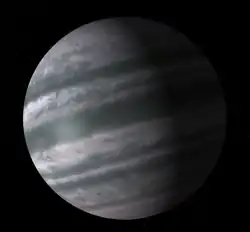HD 217107 c
HD 217107 c is an extrasolar planet[2] approximately 64 light-years away from Earth in the constellation of Pisces (the Fish). The planet was the second planet to be discovered orbiting the star HD 217107. HD 217107 c's existence was hypothesized in 1998 due to the eccentricity of the inner planet's orbit and confirmed in 2005 when radial velocity studies of the star indicated another, more distant and massive companion orbiting the star. The planet has an eccentric orbit lasting on order of a decade.
 | |
| Discovery | |
|---|---|
| Discovered by | Vogt et al. |
| Discovery site | |
| Discovery date | June 24, 2005 |
| Doppler spectroscopy | |
| Orbital characteristics | |
| 6.074±0.080 AU | |
| Eccentricity | 0.3848±0.0086[1] |
| 5189±21[1] d | |
| 2450770±16[1] | |
| 206.3±1.7[1] | |
| Semi-amplitude | 53.41±0.75[1] |
| Star | HD 217107 |
Detection and discovery
A study of the radial velocity of HD 217107 carried out in 1998 revealed that its motion along the line of sight varied over a 7.1 day cycle, indicating the presence of a planet in orbit around the star. The planet was designated HD 217107 b, and was found to be somewhat heavier than Jupiter, and orbiting extremely close to the parent star in an orbit with quite a large eccentricity.[3]
Most planets with orbital periods of less than 10 days have almost circular orbits, and its discoverers proposed that the high eccentricity of HD 217107 b's orbit could be due to the gravitational influence of a second planet in the system at a distance of several astronomical units (AU).[4] Confirmation of the existence of the second planet followed in 2005, and it was designated HD 217107 c.
The parameters of this planet was initially very weakly constrained, with a period in excess of 8 years with a high eccentricity and a minimum mass of approximately two times the mass of Jupiter. Continued observations restrained the plausible solutions substantially, resulting in the current parameters published in 2008.[5]
See also
References
- Feng, Y. Katherina; et al. (2015). "The California Planet Survey IV: A Planet Orbiting the Giant Star HD 145934 and Updates to Seven Systems with Long-period Planets". The Astrophysical Journal. 800 (1). 22. arXiv:1501.00633. Bibcode:2015ApJ...800...22F. doi:10.1088/0004-637X/800/1/22. S2CID 56390823.
- Vogt, Steven S.; et al. (2005). "Five New Multicomponent Planetary Systems" (PDF). The Astrophysical Journal. 632 (1): 638–658. Bibcode:2005ApJ...632..638V. doi:10.1086/432901.
- Fischer, Debra A.; et al. (1999). "Planetary Companions around Two Solar-Type Stars: HD 195019 and HD 217107". Publications of the Astronomical Society of the Pacific. 111 (755): 50–56. arXiv:astro-ph/9810420. Bibcode:1999PASP..111...50F. doi:10.1086/316304. S2CID 17980987.
- Fischer, Debra A.; et al. (2002). "Planetary Companions to HD 12661, HD 92788, and HD 38529 and Variations in Keplerian Residuals of Extrasolar Planets". The Astrophysical Journal. 551 (2): 1107–1118. Bibcode:2001ApJ...551.1107F. doi:10.1086/320224.
- Wright, J. T.; et al. (2009). "Ten New and Updated Multi-planet Systems, and a Survey of Exoplanetary Systems". The Astrophysical Journal. 693 (2): 1084–1099. arXiv:0812.1582. Bibcode:2009ApJ...693.1084W. doi:10.1088/0004-637X/693/2/1084. S2CID 18169921.
External links
- "HD 217107 / HR 8734". SolStation. Retrieved 2008-06-23.
- "Notes for planet HD 217107 c". The Extrasolar Planets Encyclopaedia. Retrieved 2008-06-23.